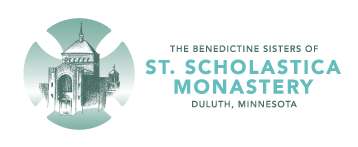 Photo by Sister Edith Bogue, OSB
Photo by Sister Edith Bogue, OSB
It was the third week of an unbelievably rich and meaningful opportunity provided by my Community to participate in a five-week renewal program for English-speaking Benedictine Sisters in Rome, the spiritual center of Catholicism, and to visit sites in Italy connected with Saints Benedict and Scholastica and the earliest Benedictine monasteries.
Even living in the “Eternal City” one could never adequately prepare to understand or appreciate the significance of all the monuments, art, and architecture depicting the layers upon layers of human and salvation history represented in this unique city more than 2,700 years old.
Even though our mentors did dutifully prepare us for each visit to a major shrine or basilica, the human mind was still searching for some way to integrate the meaning of all there was to see. How could one ever understand what led to the creation of all the magnificent domes, marble sculptures, altars and tombs, or the thousands of pieces of mosaics reverently depicting the saints and martyrs who now share Christ’s crown? What was this all about? What did it say? What did it mean to me?
 These spiral columns, decorated with mosaics, support the ‘Pulpit of the Gospels’ in the Duomo (Cathedral) of Ravello, Italy. The pulpit was created in 1272 by Nicolo di Bartolomeo. Photo from “d0gwalker” in Flickr.
These spiral columns, decorated with mosaics, support the ‘Pulpit of the Gospels’ in the Duomo (Cathedral) of Ravello, Italy. The pulpit was created in 1272 by Nicolo di Bartolomeo. Photo from “d0gwalker” in Flickr.
Listening to an illustrated lecture one morning at Sant’ Anselmo’s by Father Dan McCarthy, an American Benedictine monk who teaches there and was preparing us for a tour of several historic churches, a ”light” suddenly flashed in my brain supplying my answer, the missing link. The lecturer was explaining the Christian significance of the many spiraling columns to be observed in the ancient churches – similar to the copper ones supporting the massive baldacchino in St. Peter’s Basilica.
Often, the parallel strands circling to the top of the columns were inlaid with miniscule green and red mosaic pieces. The intertwined strands, he explained, depict the “divine-human connection.” Jesus Christ was both God and man. By becoming man, God raised up our earthly dignity and through Jesus’ death and resurrection gave us again the spark of divine life. Once a human creature is imbued with divine life, he or she can accomplish tremendous deeds for God.
It was their connection with the divine that inspired the courage of Peter, Paul, Agnes, Cecilia and the thousands of martyrs of ancient Rome to die for their cause. It was their connection with the divine manifested in the early Christians’ love for one another that eventually triumphed over the power of Imperial Rome and transformed it into a center of Christianity.
But the divine connection with the human has also inspired the greatest artists, sculptors, architects and musicians over the centuries to strive to honor the source of their inspiration through the works of their hands and their minds. What else could have inspired the colossal statue of Moses, the Pieta, the Biblical story of creation and salvation history painted on the ceiling of the Sistine Chapel and the thousands of works of art to be found in this history-laden, unique and remarkable city?
Finally, I could ask about the divine-human connection in my own life. What have I done with it? I have been infused with the same Holy Spirit as these giants of the faith. Have I used whatever talents and advantages I have been given to glorify God and draw others to the Creator of all gifts? My pilgrimage to Rome has sharpened that quest.
